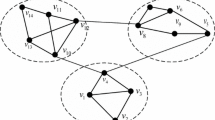Abstract
Recent years have seen the rapid development of online social networks. Many algorithms have been proposed to assign each node to more than a single community. The traditional approaches have focused on the node community, while some recent studies have shown the great advantage of edge community detection methods. This paper presents a novel algorithm used to discover local communities in networks. A local edge community can be detected by maximizing a local edge fitness function from a seed edge which was previously ranked. Meanwhile, the method can effectively control the scale and scope of the local community based on the boundary node identification, so as to obtain complete structural information of the local community. The algorithm has been tested on both synthetic and real-world networks, and has been compared to other community detection algorithms. The experimental results show significant improvement in the detection of community structures.
Access this chapter
Tax calculation will be finalised at checkout
Purchases are for personal use only
Similar content being viewed by others
References
Lancichinetti, A., Fortunato, S., Kertész J.: Detecting the overlapping and hierarchical community structure in complex networks. New J. Phys. 11(3), 033–015 (2009)
Li, S.H., Lou, H., Jiang, W., Tang, J.H.: Detecting community structure via synchronous label propagation. Neurocomputing 151(3), 1063–1075 (2015)
Feng, Z., Xu, X., Yuruk, N., Thomas, A.J.: A novel similarity-based modularity function for graph partitioning. In: Data Warehousing and Knowledge Discovery, pp. 385–396, 4654. Berlin Springer, Heidelberg (2007)
Newman, M.E.J., Girvan, M.: Finding and evaluating community structure in networks. Phys. Rev. E 69, 026–113 (2004)
Kim, P., Kim, S.: Detecting overlapping and hierarchical communities in complex network using interaction-based edge clustering. Physica A 417, 46–56 (2015)
Aidong, Z.: Protein Interaction Networks, pp. 44–47. Cambridge University Press, New York (2009)
Krista, R.Ž., Borut, Ž.: A local multiresolution algorithm for detecting communities of unbalanced structures. Physica A 407, 380–393 (2014)
Ling, C., Qiang, Y., Bolun, C.: Anti-modularity and anti-community detecting in complex networks. Inf. Sci. 275, 293–313 (2014)
Clauset, A.: Finding local community structure in networks. Phys. Rev. E 72(2), 254–271 (2005)
Chen, Q., Wu, T.T., Fang, M.: Detecting local community structures in complex networks based on local degree central nodes. Phys. A 392(3), 529–537 (2013)
Luo, F., Wang, J.Z., Promislow, E.: Exploring local community structures in large networks. Web Intell. Agent Syst. 6(4), 387–400 (2008)
Cui, Y.Z., Wang, X.Y., Eustace, J.: Detecting community structure via the maximal sub-graphs and belonging degrees in complex networks. Physica A 416, 198–207 (2014)
Zachary, W.: An information flow model for conflict and fission in small groups. Anthropol. Res. 33, 452–473 (1977)
Newman, M.E.J.: Modularity and community structure in networks. Proc. National Acad. Sci. 103(23), 8577–8582 (2006)
Newman, M.E.J.: Modularity and community structure in networks. Proc. Natl. Acad. Sci. 103(23), 8577–8582 (2006)
Author information
Authors and Affiliations
Corresponding author
Editor information
Editors and Affiliations
Rights and permissions
Copyright information
© 2016 Springer Science+Business Media Singapore
About this paper
Cite this paper
Yang, C., Du, W. (2016). Detecting Communities Based on Edge-Fitness and Node-Similarity in Social Networks. In: Hussain, A. (eds) Electronics, Communications and Networks V. Lecture Notes in Electrical Engineering, vol 382. Springer, Singapore. https://doi.org/10.1007/978-981-10-0740-8_22
Download citation
DOI: https://doi.org/10.1007/978-981-10-0740-8_22
Published:
Publisher Name: Springer, Singapore
Print ISBN: 978-981-10-0738-5
Online ISBN: 978-981-10-0740-8
eBook Packages: EngineeringEngineering (R0)




